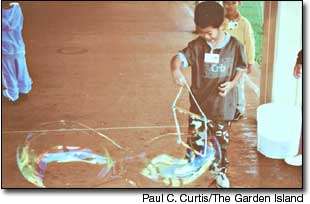HANAMA’ULU — Don’t try telling some of the youngest students at King Kaumuali’i Elementary School here that “scientific literacy has become a necessity for everyone.” They were having way too much fun, with magnets, gravity, glow-in-the-dark objects, and huge bubbles,
HANAMA’ULU — Don’t try telling some of the youngest students at King Kaumuali’i Elementary School here that “scientific literacy has become a necessity for everyone.”
They were having way too much fun, with magnets, gravity, glow-in-the-dark objects, and huge bubbles, to be bothered by the fact that they were learning about science while having a blast.
The science festival held at the school Thursday was for students in kindergarten through second grade, in and around the school library.
Facilitators included student and parent volunteers, teachers, and Leslie Bailey of Solipsys, a high-technology company which has adopted the school through Mayor Bryan J. Baptiste’s Team Tech Kauai program.
The quote in the first sentence is from The National Science Education Standards, and goes on to say, “Everyone needs to use scientific information to make choices that arise every day.
“Everyone needs to be able to engage intelligently in public discourse and debate about important issues that involve science and technology,” the standards continue.
“And everyone deserves to share in the excitement and personal fulfillment that can come from understanding and learning about the natural world.”
The goal of the science festival was to involve students in active science learning events, where they were invited to see, touch, hear, smell and even taste science objects and activities.
They were expected to describe objects and events, ask questions, acquire knowledge, construct explanations of their observations, test those explanations, and communicate their ideas.
Students used soapy water to make bubbles, learned about lenses and their different impacts on light and objects, explored motion stations involving friction, gravity, centrifugal force and other laws of physics, used paper cups with strings attached as telephones, made musical instruments, and tasted various sweet and sour items to get senses of “acid,” “base” and “neutral” as terms scientists use for chemicals that taste sour, bitter or neither, respectively.


